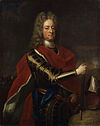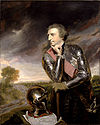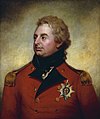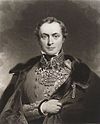
Prince George, Duke of Cambridge was a member of the British royal family, a grandson of King George III and cousin of Queen Victoria. The Duke was an army officer by profession and served as Commander-in-Chief of the Forces from 1856 to 1895. He became Duke of Cambridge in 1850 and field marshal in 1862. Deeply devoted to the old Army, he worked with Queen Victoria to defeat or minimise every reform proposal, such as setting up a general staff. His Army's weaknesses were dramatically revealed by the poor organisation at the start of the Second Boer War.

Admiral of the Fleet is a five-star naval officer rank and the highest rank of the Royal Navy, formally established in 1688. The five-star NATO rank code is OF-10, equivalent to a field marshal in the British Army or a Marshal of the Royal Air Force. Apart from honorary appointments, no new admirals of the fleet have been named since 1995, and no honorary appointments have been made since 2014.
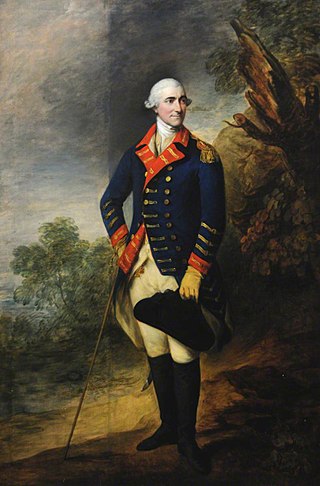
Field Marshal Henry Seymour Conway was a British general and statesman. A brother of the 1st Marquess of Hertford, and cousin of Horace Walpole, he began his military career in the War of the Austrian Succession. He held various political offices including Chief Secretary for Ireland, Secretary of State for the Southern Department, Leader of the House of Commons and Secretary of State for the Northern Department. He eventually rose to the position of Commander-in-Chief of the Forces.

Field Marshal John Ligonier, 1st Earl Ligonier,, was a French Huguenot exile, born Jean Louis de Ligonier in Castres, Southern France. He had a long and distinguished career in the British army and was appointed Commander-in-chief in 1757.
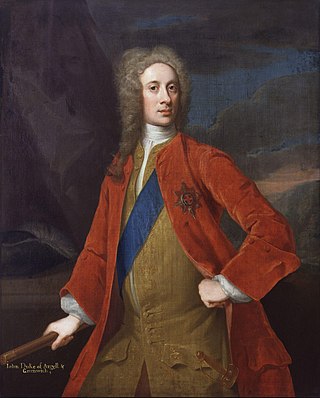
Field Marshal John Campbell, 2nd Duke of Argyll, 1st Duke of Greenwich,, styled Lord Lorne from 1680 to 1703, was a Scottish nobleman and senior commander in the British Army. He served on the continent in the Nine Years' War and fought at the Battle of Kaiserwerth during the War of the Spanish Succession. He went on to serve as a brigade commander during the later battles of the War of the Spanish Succession. Next he was given command of all British forces in Spain at the instigation of the Harley Ministry; after conducting a successful evacuation of the troops from Spain, he became Commander-in-Chief, Scotland. During the Jacobite Rebellion, he led the government army against the Jacobites led by the Earl of Mar at the Battle of Sheriffmuir. He went on to serve as Lord Steward and then Master-General of the Ordnance under the Walpole–Townshend Ministry.

Field Marshal John Dalrymple, 2nd Earl of Stair, was a Scottish soldier and diplomat. He served in the Nine Years' War and the War of the Spanish Succession and, after a period as British Ambassador in Paris, became a military commander at the Battle of Dettingen during the War of the Austrian Succession.
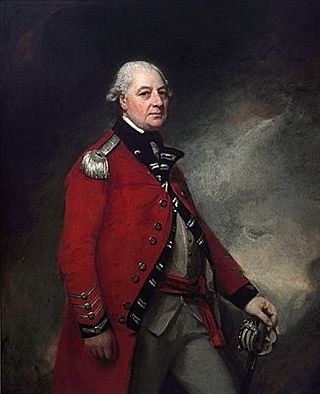
Field Marshal George Townshend, 1st Marquess Townshend, PC, known as The Viscount Townshend from 1764 to 1787, was a British soldier and politician. After serving at the Battle of Dettingen during the War of the Austrian Succession and the Battle of Culloden during the Jacobite Rising, Townshend took command of the British forces for the closing stages of the Battle of the Plains of Abraham during the Seven Years' War. He went on to be Lord Lieutenant of Ireland or Viceroy where he introduced measures aimed at increasing the size of Irish regiments, reducing corruption in Ireland and improving the Irish economy. In cooperation with Prime Minister North in London, he solidified governmental control over Ireland. He also served as Master-General of the Ordnance, first in the North Ministry and then in the Fox–North Coalition.

The Chief of the General Staff (CGS) has been the title of the professional head of the British Army since 1964. The CGS is a member of both the Chiefs of Staff Committee and the Army Board; he is also the Chair of the Executive Committee of the Army Board. Prior to 1964, the title was Chief of the Imperial General Staff (CIGS). Since 1959, the post has been immediately subordinate to the Chief of the Defence Staff, the post held by the professional head of the British Armed Forces.
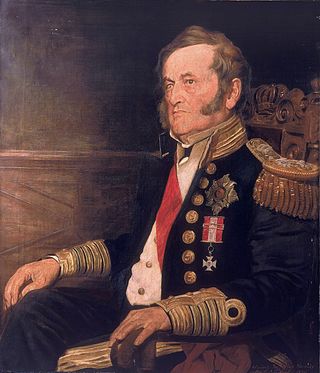
Admiral of the Fleet Sir Fairfax Moresby GCB was a Royal Navy officer. As a junior officer he took part in the unsuccessful expedition to capture Ferrol in Spain during the French Revolutionary Wars. He later saw action during the blockade of Brest during the Napoleonic Wars before becoming commanding officer of a sloop which was sent to the Aegean Sea to defend the population of Malta from pirates; the grateful people presented him with a sword. He then sailed to the Adriatic Sea where he led a naval brigade providing artillery support to the Austrian forces during the siege of Trieste. He went on to be senior naval officer at the Cape of Good Hope and then senior officer at Mauritius, with orders to suppress the slave trade: he concluded the Moresby Treaty with Seyyid Said, the imam of Muscat, restricting the scope of local slave trading and conferring on English warships the right of searching and seizing local vessels.
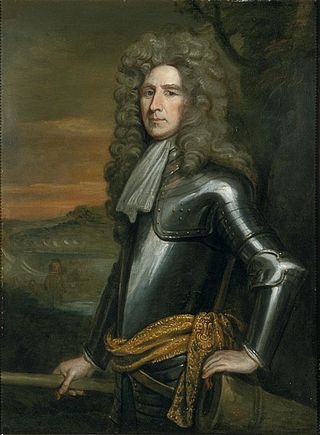
Henry Sydney, 1st Earl of Romney was an English Army officer, Whig politician and peer who served as Master-General of the Ordnance from 1693 to 1702. He is best known as one of the Immortal Seven, a group of seven Englishmen who drafted an invitation to William of Orange, which led to the November 1688 Glorious Revolution and subsequent deposition of James II of England.

Major-General John Armstrong was a British military engineer and soldier, who served as Chief Royal Engineer and Surveyor-General of the Ordnance.

Field Marshal Sir Hew Dalrymple Ross, was a British Army officer. After seeing active service during the Irish Rebellion of 1798, he fought as a troop commander in many of the battles of the Peninsular War and the Hundred Days. He went on to become the Artillery Commander, Northern District with delegated command over all the forces of the four northern counties before being promoted to Deputy Adjutant-General, Royal Artillery. Ross was the last person to hold the title of Lieutenant-General of the Ordnance, assuming responsibility for the artillery component sent to take part in the Crimean War under Lord Raglan. After the war he served as Master Gunner, St James's Park, a senior ceremonial post in the Royal Artillery.

George Legge, 1st Baron Dartmouth PC was an English Royal Navy officer and peer who was appointed Admiral of the Fleet by James II of England in September 1688. However, he failed to intercept a Dutch invasion force under William III that landed at Torbay on 5 November 1688 and was dismissed following the Glorious Revolution.

Admiral of the Fleet Sir William Rowley KB was a Royal Navy officer. He distinguished himself by his determination as commander of the vanguard at the Battle of Toulon in February 1744 during the War of the Austrian Succession. He went on to be Commander-in-Chief of the Mediterranean Fleet in August 1744 and successfully kept the Spanish and French fleets out of the Mediterranean area but was relieved of his command following criticism of his decision as presiding officer at a court-martial.
The battle of Leeds took place during the First English Civil War on 23 January 1643, when a Parliamentarian force attacked the Royalist garrison of Leeds, Yorkshire. The attack was partly dictated by the need to maintain local support for the Parliamentarian cause; the Earl of Newcastle had recently shifted the balance of power in Yorkshire in the Royalists' favour with the addition of his 8,000-strong army, and sent one of his commanders, Sir William Savile to capture Leeds. The West Riding of Yorkshire relied on the cloth trade, and Ferdinando, Lord Fairfax sent his son, Sir Thomas Fairfax to bolster the defences of nearby Bradford, before agreeing to his request to attack Leeds.

General William Belford was a British artillery officer who began his career in 1726. He was part of the first generation of artillery officers selected and promoted on merit, rather than connections.
Inspector-General of the Forces was a British Army appointment. There were also Inspectors-General for the different arms.

The Storming of Farnham Castle occurred on 1 December 1642, during the early stages of the First English Civil War, when a Parliamentarian force attacked the Royalist garrison at Farnham Castle in Surrey. Sir John Denham had taken possession of the castle for the Royalists in mid-November, but after the Royalists had been turned back from London at the Battle of Turnham Green, a Parliamentarian force under the command of Sir William Waller approached the castle. After Denham refused to surrender, Waller's forces successfully stormed the castle. They captured it in under three hours, mostly due to the unwillingness of the Royalist troops to fight. This allowed the Parliamentarians to get close enough to breach the gates, after which the garrison surrendered.
The Battle of Tadcaster took place during the First English Civil War on 7 December 1642, when a Royalist force attacked the Parliamentarian garrison of Tadcaster, Yorkshire, which was held by between 900 and 1,500 soldiers under the command of Ferdinando Fairfax, Lord Fairfax. The Earl of Newcastle marched out of York on 6 December, and split his force of 6,000 into two; he took 4,000 infantry down the main York–Tadcaster road to attack the town from the east, while sending a deputy, the Earl of Newport, with a further 1,500 to circle around and trap the Parliamentarians by attacking from the north-west.







